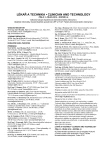The biomechanical movements for the disabled based on art therapy
The purpose of the published work is to open up to new possibilities in the area of treatment processes within rehabilitation, physiotherapy and consequent movement re-education processes for people with disabilities, post-traumatic conditions, or degenerative disease. Art therapy presents a special kind of locomotive biomechanical algorithms focused on creative skills development, emotional development of physically or socially disturbed individuals. Art therapy is used for training and maintenance of motor and sensory functions, as a controlled and targeted activity during which the clients work with the artistic means of expression. The work proposes and describes a methodology, whose purpose is to follow and build on the classic rehabilitation of the physically disabled patient. To compare the effectiveness of the proposed methodology, the observations were made in two patient groups. The control group A and the experimental group B were included in the art therapy of the methodology of the ankle joint movement. After completing the art therapy, the experimental group B showed demonstrably better results in improving their plantar flexion by 8° on average compared to group A. The motivation and subsequent improvement of the patients’ agility is the best answer to questions of quality and contribution of using the Methodology of biomechanical movements using art therapy.
Keywords:
art therapy, motor and sensory functions, biomechanical movements, artistic means of expression, biomechanical principles, methodology, biomechanics of joints and systems, rehabilitation, physiotherapy, physical disability
Autoři:
Jana Mušinská 1; Ivana Židík 2; Jozef Živčák 1
Působiště autorů:
Faculty of Mechanical Engineering, Department of Biomedical Engineering and Measurement, Technical University, Letná 9, Košice, Slovak Republic
1; Faculty of Arts, Institute of Music and Arts, University of Presov in Presov, Ul. 17. novembra č. 1, Prešov, Slovak Republic
2
Vyšlo v časopise:
Lékař a technika - Clinician and Technology No. 3, 2014, 44, 12-16
Kategorie:
Původní práce
Souhrn
The purpose of the published work is to open up to new possibilities in the area of treatment processes within rehabilitation, physiotherapy and consequent movement re-education processes for people with disabilities, post-traumatic conditions, or degenerative disease. Art therapy presents a special kind of locomotive biomechanical algorithms focused on creative skills development, emotional development of physically or socially disturbed individuals. Art therapy is used for training and maintenance of motor and sensory functions, as a controlled and targeted activity during which the clients work with the artistic means of expression. The work proposes and describes a methodology, whose purpose is to follow and build on the classic rehabilitation of the physically disabled patient. To compare the effectiveness of the proposed methodology, the observations were made in two patient groups. The control group A and the experimental group B were included in the art therapy of the methodology of the ankle joint movement. After completing the art therapy, the experimental group B showed demonstrably better results in improving their plantar flexion by 8° on average compared to group A. The motivation and subsequent improvement of the patients’ agility is the best answer to questions of quality and contribution of using the Methodology of biomechanical movements using art therapy.
Keywords:
art therapy, motor and sensory functions, biomechanical movements, artistic means of expression, biomechanical principles, methodology, biomechanics of joints and systems, rehabilitation, physiotherapy, physical disability
Zdroje
[1] Garner, R. L. Factors in neuropsychological Art Therapy. American Journal of Art Therapy, Vol. 34, No. 41996, p. 1-6.
[2] Fabrici, J. Základy arteterapie. Praha, 2002. 176 p.
[3] Gúth, A. et al. Vyšetrovacie metodiky pre fyzioterapeutov. Bratislava, 2004. 400 p.
[4] Hromádková, J. et al. Fyzioterapie. Jinočany: H& H, 2002. 428 p.
[5] Živčák, J., Knežo, D. Biomechanika hybnosti. Prešovská Univerzita v Prešove, 2008. 208 p.
[6] Bartoníček, J., Hert, J.,Základy klinické anatomie pohybového aparátu. Praha, 2004. 256 p.
[7] Dylevsky, I. Kineziologie - Základy strukturálni kineziologie. Praha, 2009. 235 p.
Štítky
BiomedicínaČlánok vyšiel v časopise
Lékař a technika

2014 Číslo 3
Najčítanejšie v tomto čísle
- Vliv průtočného odporu dýchacích cest a alveolární poddajnosti na dechový objem při vysokofrekvenční oscilační ventilaci
- Health Technology Assessment for Medical Devices
- Monitoring of EMG to force ratio using new designed precise wireless sensor system
- Remote Pulse Oximetry Imaging – Fundamentals and Applications
